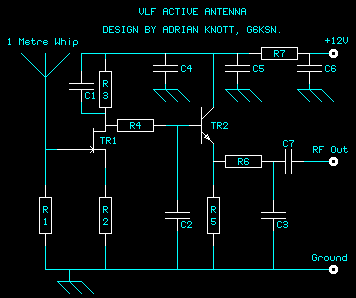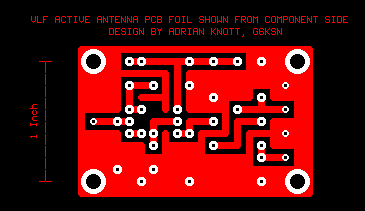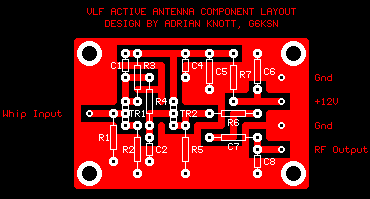|
Tuned VLF Active
Antenna
By
Adrian Knott, United Kingdom
I have had an interest in VLF for some years now. The first thing
that I ever heard were the navigation signals on around 10 KHz
when I was experimenting with a ferrite rod and lots of copper
wire in an attempt to bug my parents telephone as a young schoolboy.
I was fascinated, to be quite honest the experience scared the
hell out of me. It wasn't until several years later that I put
two and two together and actually realised hat I had been listening
to. If I were to repeat the experiment now I probably wouldn't
hear a thing as the treble response of my hearing has undoubtably
been impaired over the years.
Since the
age of 18, I have lived mainly in high rise accommodation and
so antennas for HF receive have always been somewhat of a compromise.
I have found that indoor antennas do not work in high rise
buildings due to lots of attenuation from concrete and steel.
Interference from TV timebase and the like is also much worse
indoors. During the past few years I have tried Frame Aerials,
Ferrite rod aerials, I even tried the lightning arrestor at one
point (not bad but difficult to resonate and a bit lethal in a
thunderstorm) and active whip aerials.
A one metre
whip in free space will develop a fair signal voltage, even on
VLF but there is next to no current ie the impedance is high.
A means of matching to 50 ohms is required. This can be accomplished
by transformer matching but results will not be as good as amplifying
the signal at source. I did consider a tuned version of this antenna
but the inductors tend to get a little large. The antenna is good
down to at least 10 KHz and is a few dB down at 200 KHz. You may
like to experiment with the filtering to see if Long wave and
Medium wave may be covered but do beware that the greater the
bandwidth of the antenna, the more likely that undesirable interaction
between stations will occur (cross mod) due to non linearity in
the amplifying stages.
Circuit
Description. The
whip which is 1 to 1.5 Metres in length is connected to the gate
of TR1 a field effect transistor in common source mode which has
a very high input impedance and a moderately low output impedance
(around 1 Kilohm in this case). The gate leak resistor R1 is of
sufficiently high resistance as to be of little consequence. The
amplified RF is developed across R3. R2 biases TR1. C1 helps to
limit the high frequency response of the amplifier. The output
at the drain of TR1 feeds emitter follower TR2 via a low pass
filter consisting of R4 and C2. This stage has a voltage gain
of just less than one but a high current gain such that the output
impedance is lowered to a few ohms. Feed to 50 ohm coaxial cable
is taken from the emitter of TR2 via R6 and C7, resistive matching
and DC blocking respectively. R6 and C8 also form another low
pass filter to help with cross modulation.
12
Volts is fed to the amplifier via R7, C4, C5 and C6 a line noise
filter. And that's it. Obviously it needs a remote 12 volt PSU.
Something along the lines of a 3 VA transformer and a 78L12 should
be more than adequate as the unit only draws a few milliamps.
No
alignment is necessary but placement is important. An outdoor
location away from power lines and sources of interference is
a must if good operation is to be realised. If the unit is mounted
on a metal pole or mast then connect a ground wire from the unit
to the metallic structure.
Components.
R1.....10M.
Metal Oxide.
R2.....2K2.
R3.....4K7.
R4.....10K.
R5.....1K.
R6.....56 ohm.
R7.....100 ohm.
TR1....2N3819.
TR2....BFY51.
C1.....560pF.
C2.....33pF.
C3.....2n2F.
C4.....100mF. 16 Volt.
C5.....100nF.
C6.....100nF.
C7.....470nF.
Whip...Telescopic 1.5 metre.

Schematics

PCB Board

Component
layout
This
document and the accompanying files are the original work of the
author, Adrian
Knott G6KSN. Please feel free to distribute these files.
|





